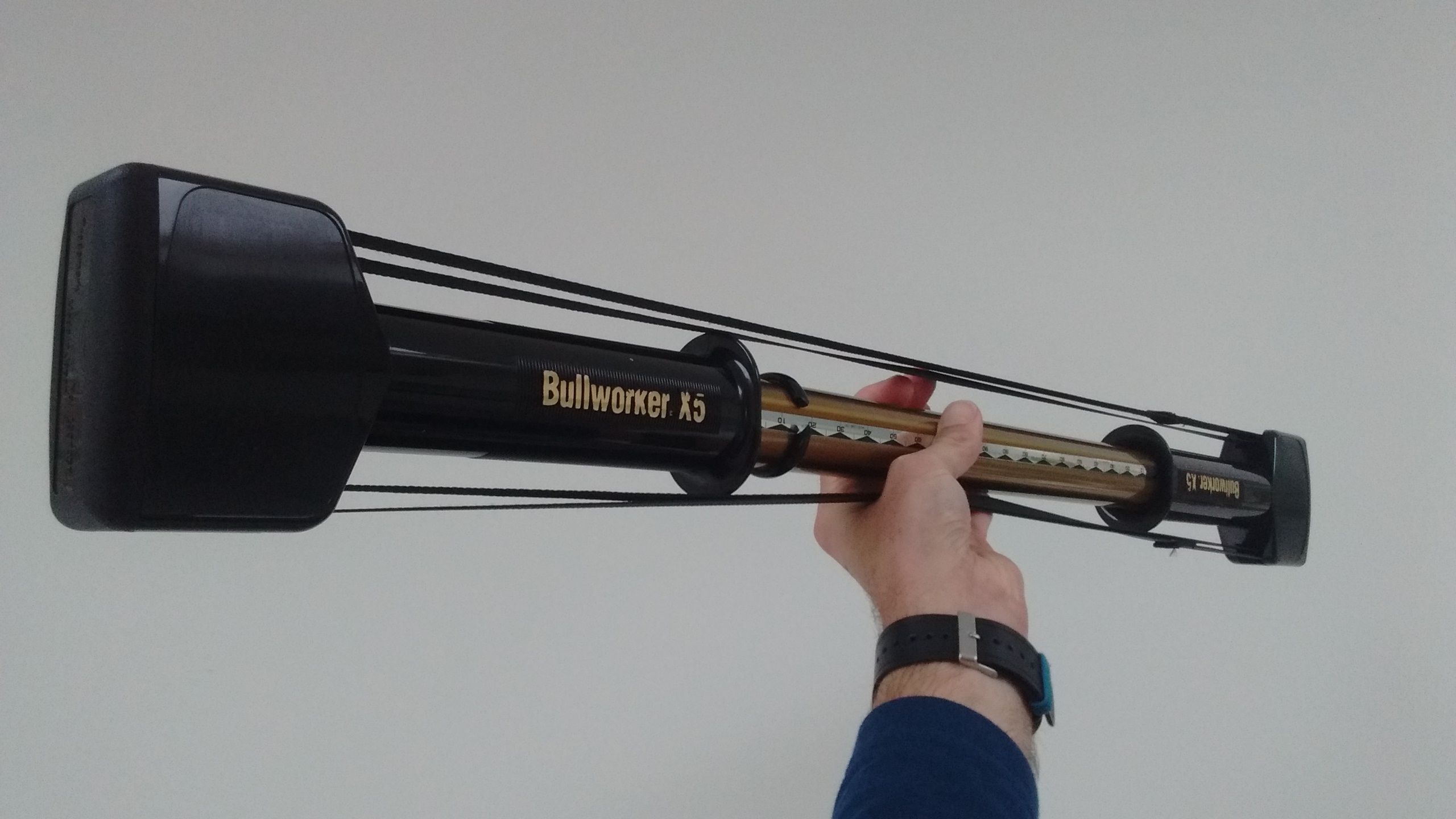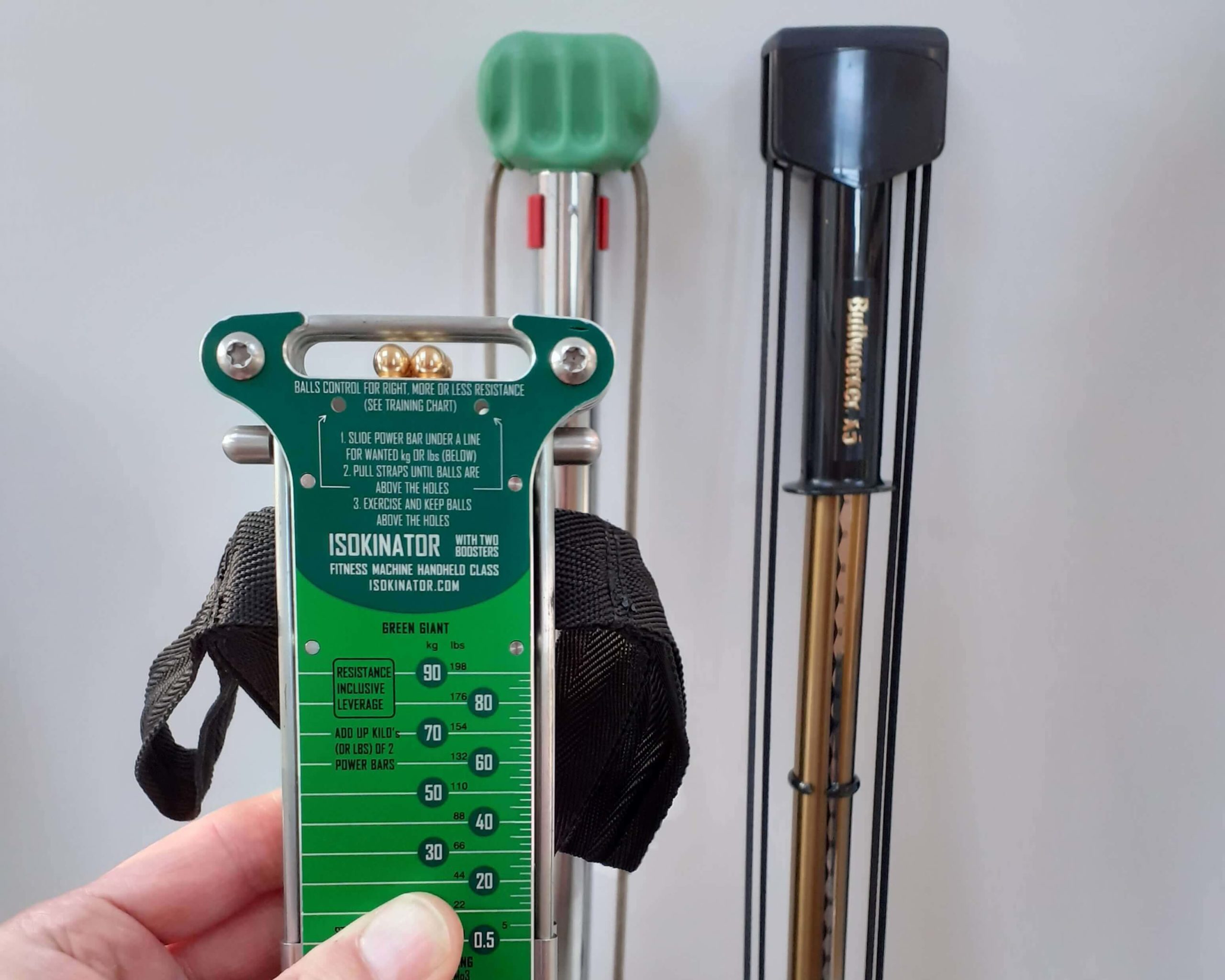I’m a big fan of the Bullworker, Isokinator and Iso Bow and even ended up getting rid of my weight set to focus on training with these tools. I thought it would be fun to describe my experiences.
What is a Bullworker?
The Bullworker (link to Amazon) was invented by Gert F. Kölbel in the 1960s. It consists of two metal cylinders that slide one inside the other with a set of handles at each end. A strong spring sits within the cylinders which compresses as the handles are squeezed together. In addition, a band connects the two handles, which when pulled apart, also causes the spring to compress.

How do you use a Bullworker?
The Bullworker can he held and compressed in various positions to work different muscles in the body. However, at its core, the Bullworker is operated in one of two ways: either the handles are compressed together directly or the bands are pulled apart, which, indirectly compresses the handles. It is the strong spring within the Bullworker that offers the resistance to the movement.
The Bullworker can be used in an isometric fashion, whereby the handles are squeezed together and held in place for a specific period of time before being released. This is how I generally train.
Alternatively, the handles can be squeezed and released in a rhythmic fashion for a set number of reps. I find that this builds up a tremendous burn in the muscle itself.
How long should you hold isometric exercises?
The general recommendation is to hold the isometric hold for 7-10 seconds. I find this builds up a great deal of strength in the movement. However, my preference is to hold the position for 50 – 60 seconds.
I find that you can really feel the muscle work when held for this longer duration and it develops a great ‘mind muscle’ connection. This style of training is also much more geared towards hypertrophy as opposed to strength.
Is it better to hold or do reps?
Holding the Bullworker in a fixed position for an isometric rep can build both tremendous strength as well as muscle gains. Alexander Zass, a professional strongman in the 1920s and 30s, used to train with isometrics to gain amazing tendon strength.
Once I’ve trained in this way, I then like to use the Bullworker for small pumping reps to drive blood and therefore oxygen and nutrients into the muscle to help it recover.
I’ve written an article on whether you can perform isometrics everyday.
What muscles does a Bullworker work?
The Bullworker can be used to work all the main muscles in the body. I would have to say though that it’s much better suited to working the upper body. I always find the lower body exercises slightly awkward to perform.
Can you build muscle with a Bullworker?
I would say that you can definitely build muscle with the Bullworker. Certainly I feel that my muscles are much more solid and harder than they were before I trained. I’ve also noticed I’ve gotten much stronger using this tool; the device has a ring that moves as you compress the device which you can use to track your progress.
I wouldn’t necessarily use the device if I was solely interested in bodybuilding but since I want to look reasonably toned whilst also being strong, it’s my preferred method of training.
Is a Bullworker any good?
I really love using my Bullworker. It’s a super convenient exercise tool that I can use in the comfort of my own home whilst watching television.
This makes it much more likely that I’ll be consistent in my training since there are very few hurdles I have to overcome to start: I don’t have to travel to the gym, I don’t have to get changed, I don’t have to spend time away from the family etc.
Isometrics are a great way to develop strength and develop a dense, muscular physique. The Bullworker can just about fit into a suitcase if you ever go travelling.
What is a Isokinator?
Like the Bullworker, the Isokinator was also invented by Gert F. Kölbel (he was a pretty bright guy!).

It’s about the size of a large television remote control made of metal with two straps coming out of each side: one designed for the hands and one for the feet.
The device is made in Germany and has the high quality feel that you’d expect from German engineering. It’s certainly very solid weighing about X lbs.
The straps are attached to metal prongs within the device. There’s a slider on each side which determines the degree to which these prongs can flex.
At the top of each prong is a golden ball. The idea is that you pull the straps so that the golden balls move apart and are then kept in line with two holes in the casing of the isokinator.
With the golden balls in position, you can then perform different movements depending on which muscles you want to develop.
How does the Isokinator work?
By pulling apart the golden balls and keeping them in position, you are keeping constant tension on the muscles as the exercise is performed.
Time under tension, is one of the triggers for muscle development. By keeping an eye on the position of the balls, you can see whether you need to increase or reduce the tension as you pull on the straps.
The Isokinator’s instruction manual calls this muscle tension a “power block”. As you pull apart the straps you can feel the muscle tension in whatever muscles you’re focusing on.
Once you’ve built up this tension, you then perform one a number of movements to target different muscles in the body. You’re moving whilst still maintaining a high level of tension in the muscles.
You’re supposed to perform 10 reps in each set, for a maximum of three sets per muscle group. Once you can complete 10 reps for each set, you then increase the level of resistance using the slider on the side of the Isokinator.
How good is the Isokinator?
The Isokinator is an excellent bit of kit. It’s a very different style of workout than say using the Bullworker or with conventional weights.
WIth the Bullworker, you’re mainly using isometrics, where the muscles contract in a fixed position, or with partial rep ranges.
With weights, you only tend to feel the tension at certain points of the movement. For instance, with a bicep curl, you’ll experience maximum muscle tension at the half way point where the forearm is parallel to the floor. In contrast, very little tension is experienced at either end of the movement: at the top or the bottom
With the Isokinator, you’re doing full range movements where you feel muscular tension throughout the entire movement. This makes this form of exercise extremely intense. I find it surprising how tiring this type of training is, yet you complete it in about 20 minutes or so, making it very time efficient.
The isokinator is also very well made. I have the feeling it’s going to last a very long time. The only thing I can see wearing out are the straps but even these are made out of a strong nylon webbing.
The one thing I would say is that I bought the Green Giant version (link to Amazon), which I believe offers twice the resistance of the original. I thought I was reasonably strong but I’m still working on the lowest level of resistance. I am increasing in strength as I’m increasing the number of reps I’m able to do. I imagine that for most people, the original version (link to Amazon) would be just fine.
The Isokinator is also quite expensive. Don’t get me wrong, it’s very high quality but it does come at a price. Personally I think it’s worth it. I find that lifting with weights puts a strain on my joints and tendons. I’ve actually sold my dumbbell and barbell weights set and rely solely on the devices here to maintain my strength,
What is an Iso Bow?
The Iso Bow (link to Amazon) is a relatively new device made by Bullworker. It’s a very simple design: a nylon strap in the shape of a loop that has been sewn together in the middle to create a figure of eight. Two hollow, foam covered handles have been threaded onto each end of the loop.

How does the Iso Bow work?
You can use the Iso Bow in a number of ways.
Firstly, it can be used isometrically. You can grab each handle and pit one set of muscles against another. For instance, you can grab each handle and exercise the muscles of the arm by trying to move one handle upwards with the bicep of one arm whilst pushing the other down with the tricep of the other arm. The iso bow won’t actually move but each set of muscles will get a vigorous workout.
The Iso Bow can also be used dynamically very much like the Isokinator. In fact, Isokinator have a free app that demonstrates all the exercises you can do. You can complete these exercises using the Iso Bow.
I also use the Iso Bow as a stretching aid. Sitting with my legs outstretched, I’ll loop one handle over my foot and grap with other handle with my hand, I can then carefully pull myself forward to stretch out my hamstrings. With a bit of imagination, the Iso Bow can be used in a range of stretching exercises.
How good is the Iso Bow?
The Iso Bow is a lot cheaper than both the Isokinator and Bullworker and is also very compact meaning it will fit into a coat pocket.
It’s also very well made, meaning it can more than withstand the forces the body can subject it to. The handles are very comfortable which is particularly important when you’re using it under heavy load.
A significant difference is that, unlike the Isokinator, there is no way to tell how much force you’re using. You have to rely on feel and this can take time to master if you’re not used to it.
I mainly use the Iso Bow if I’m travelling, when I don’t want to risk losing my Bullworker or Isokinator, or as a stretching aid as I’ve mentioned.
Related Articles:
Original, Vintage Bullworker X5 Review and Exercises
The Bullworker Iso-Bow Review
Isometrics build muscle fast!!
Isometrics for martial arts: how you can get really strong
Is the Bullworker as good as weights?
Bullworker vs Isokinator vs Isobow
The best isometric exercise equipment 2022(with pictures)
Will a Bullworker build muscle?
How often do you workout with a Bullworker?
The Bullworker: how much force does it exert?
